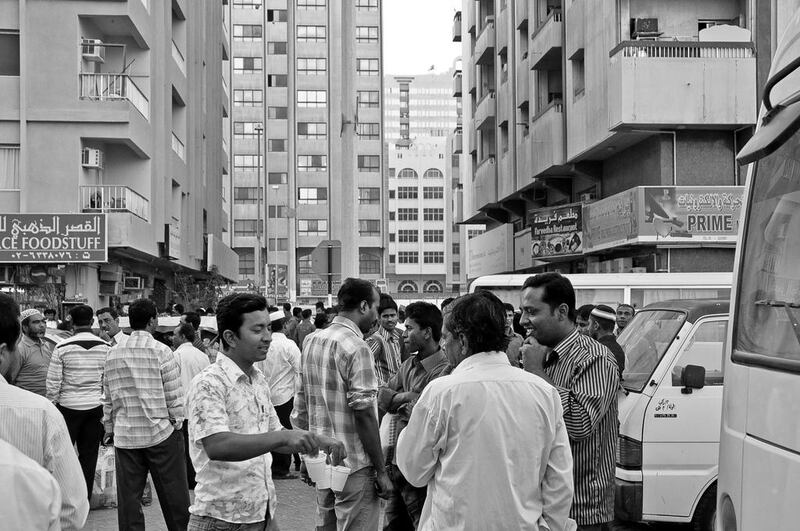The square that surrounds Al Markaziyah’s Ali bin Mushid mosque is already packed with children playing football, gossiping maids and packs of feral kittens by the time Hazrat Uddin arrives to perform his daily balancing act.
Uddin’s feat, which the Pakistani performs unnoticed each evening amid the neighbourhood’s bins, substations and neon-lit alleyways, involves a Flying Pigeon and kilograms of cardboard.
The Flying Pigeon is Uddin’s trusty Chinese bicycle, which he rides with the confidence and precision of a high wire artist between the parked cars packed in the betel-stained backstreets among Abu Dhabi’s Liwa, Lulu and Khalifa Streets and the manicured Corniche.
The cardboard consists of many oversized stacks of collapsed boxes, like giant jigsaw pieces, that are bound together with string and clasped, vice-like, to the side of Uddin’s bike.
Like kabariwalas across South Asia, Uddin makes money from the things we no longer want, collecting objects that can be recycled, reused or sold on at a profit, with a speed and efficiency that is the envy of most municipalities.
But despite his skills, Uddin’s is a life in the shadows. Renumerated rather than appreciated, tolerated but unnoticed, by day he works in an office and at night he enters the world of waste, an operative of the kind of “informal urbanism” upon which cities have always depended.
For the Indian poverty campaigner Sheela Patel, the fact that modern city governments and planning authorities continue to ignore “informal urbanism” in their master plans is a fact that is as unjust as it is short-sighted.
“We’ve always dealt with the formal city. We forget that that formality is serviced by the informal sector,” Patel explained at the recent CityLab 2015 conference in London.
“There is lots of excitement about digital mapping technologies and big data at the moment but when planning comes into a city it never acknowledges informality,” said Patel, founder of the Bombay-based Sparc, the Society for the Promotion of Area Resource Centres, which campaigns for the rights of the city’s street dwellers.
Patel was joined at the CityLab conference by the campaigner and environmentalist Sunita Narain, who cited the example of kabariwalas such as Uddin as evidence of a culturally-appropriate approach to an alternative model for urban life.
“We don’t value them because we are so fascinated with what the developed world is doing. We don’t look at what we already have and what could be rejuvenated to deal with the [urban] situation we face.”
For Narain, director general of the Centre for Science and Environment, in New Delhi, the use of western models of city thinking are inappropriate for the complexities of urban life in the Global South.“We do not have a model of urbanisation that is appropriate for our world ... We need to understand that if India wants smart cities, which is what government is talking about, we need to find a model of urbanisation that is appropriate not for the rich of our cities but for the poor. Unless urbanisation is affordable, it will not be sustainable.”
The value of Abu Dhabi’s informal urbanism will be one of the topics for discussion on Saturday, Nov. 21 during “Design Lab: An Instant Urban Phenomenon”, a panel discussion that is being chaired by the UAE University-based architect and academic Yasser Elsheshtawy, as part of Abu Dhabi Art.
An expert on urbanism in the Arabian Gulf who was recently selected as curator for the UAE National Pavilion at the 2016 Venice Architecture Biennale, Elsheshtawy’s research was the subject of a recent exhibition, “Little Bangladesh – Mapping Abu Dhabi”, held at New York University in Manhattan.
Elsheshtawy conducted the research under the auspices of Find (Forming Intersections and Dialogues), a New York University Abu Dhabi initiative dedicated to exploring the relationships between people and the UAE’s urban and natural landscapes.
“It’s about looking at an alternative reading of the city that goes beyond traditional models,” the academic explains.
“People produce their own social spaces. It may not be that visible in Abu Dhabi but it does happen.”
Informed by the ideas of urban researchers such as William H Whyte, author of The Social Life of Small Urban Spaces, and architectural theorists such Jan Gehl and Kevin Lynch, Elsheshtawy's is a ground-up approach to urbanism that sees lessons and value in life as it is lived and in the everyday.
“You can see it in the way that children play in parking lots and in the informal mosques that you find inside Abu Dhabi’s super blocks,” Elsheshtawy says.
“It’s in the gardens that people plant in front of their stores and, most importantly, in the gathering sites that workers create on street corners.
“I’ve been trying to move beyond the notion of the city as a spectacle, of gleaming towers and fancy shopping malls, to understand that there is something else happening in this city.”
• Design Lab: An Instant Urban Phenomenon takes place November 21, 2015, at 3pm at Manarat Al Saadiyat.
Nick Leech is a features writer at The National.





